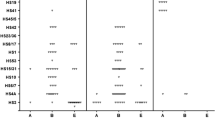Abstract
Serotyping (heat stable antigens) was performed on 398 strains of Campylobacter jejuni from faeces of human enteritis cases in England. Strains isolated over 12 months at three locations were heterogeneous with 33 HS serotypes represented. HS1 and HS4 complex were the predominant types (34% of all strains). The monthly strain frequency distributions were similar at the three locations. The late spring peak appeared to be associated with a rise in miscellaneous serotypes rather than with the emergence of any characteristic predominant serotype. PFGE DNA restriction profiling provided evidence of a high degree of genomic diversity within the common HS1 and HS4 complex serotypes, irrespective of the geographical source, yet some subtypes were common to more than one location. The study showed that C. jejuni strain subtypes from human enteric infections in England were highly diverse, and that HS serotyping must be combined with a more discriminatory subtyping method such as PFGE DNA profiling to provide an accurate basis for epidemiological surveillance.
Similar content being viewed by others
References
Skirrow MB, Blaser MJ. Clinical and epidemiologic considerations. In: Nachamkin I, Blaser MJ, Tompkins LS (eds), Campylobacter jejuni: Current Status and Future Trends. Washington, DC: ASM Press, 1992: 3–8.
Healing TD, Greenwood MH, Pearson AD. Campylobacter and enteritis. Rev Microbiol 1992; 3: 159–167.
CDSC. Other gastrointestinal tract infections. Comm Dis Rep 1995; 5: 6.
Cowden JM. Campylobacter: Epidemiological paradoxes. Br Med J 1992; 305: 132–133.
Pearson AD, Healing TD. The surveillance and control of campylobacter infection. CDR Rev 1992; 12: R133–139.
Advisory Committee on the Microbiological Safety of Food. Interim report on Campylobacter. London: HMSO, 1992.
Barrow GI, Feltham RKA (eds). Cowan and Steel's manual for the identification of medical bacteria. Cambridge: Cambridge University Press, 1993.
Lior H. New extended biotyping scheme for Campylobacter jejuni, Campylobacter coli and ‘Campylobacter laridis’. J Clin Microbiol 1984; 20: 636–640.
Penner JL, Hennessy JN. Passive haemagglutination technique for serotyping Campylobacter fetus subsp. jejuni on the basis of soluble heat stable antigens. J Clin Microbiol 1980; 12: 732–737.
Gibson JR, Sutherland K, Owen RJ. Inhibition of DNase activity in PFGE analysis of DNA from Campylobacter jejuni. Lett Appl Microbiol 1994; 19: 357–358.
Owen RJ, et al. A molecular subtyping scheme for serotypes HS1 and HS4 of Campylobacter jejuni. J Clin Microbiol 1995; 33: 872–877.
Skirrow MB. Campylobacter enteritis, a ‘new’ disease. Br Med J 1977 (ii): 9–11.
Tauxe RV. Epidemiology of Campylobacter jejuni infection in the United States and other industrialised nations. In: Nachamkin I, Blaser MJ, Tompkins LS (eds), Campylobacter jejuni: Current Status and Future Trends. Washington, DC: American Society for Microbiology, 1992; 9–19.
Skirrow MB, Jones DM, Sutcliffe E, Benjamin J. Campylobacter bacteraemia in England and Wales, 1981–91. Epidemiol Infect 1993; 110: 567–573.
Fricker CR, Park RWA. A two-year study of the distribution of thermophilic campylobacter in human, environmental and food samples from the Reading area with particular reference to toxin production and heat-stable serotype. J Appl Bacteriol 1989; 66: 477–490.
Gibson JR, Fitzgerald C, Owen RJ. Comparison of PFGE, ribotyping and phage-typing in the epidemiological analysis of Campylobacter jejuni serotype HS2 infections. Epidemiol Infect 1995; 115: 215–225.
Author information
Authors and Affiliations
Rights and permissions
About this article
Cite this article
Owen, R., Slater, E., Telford, D. et al. Subtypes of Campylobacter jejuni from sporadic cases of diarrhoeal disease at different locations in England are highly diverse. Eur J Epidemiol 13, 837–840 (1997). https://doi.org/10.1023/A:1007497005152
Issue Date:
DOI: https://doi.org/10.1023/A:1007497005152




